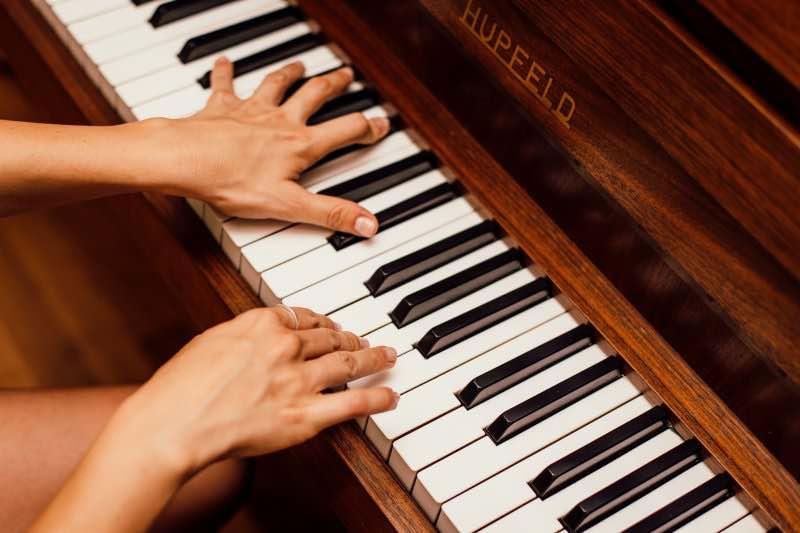From a beginner piano player to a more advanced pianist, we can ALL benefit from working on our technique. It is and should be, a continual process that is consistent and regular. Technique is how we execute the notes on the page with our fingers, our hands, and our whole body. It is important to note that if you want to improve your playing ability, then work on the proper technique of your body and hand position and include it in your daily practice routine to develop good habits and long-lasting benefits.
Strengthen Your Hand Muscles
Did you know that your piano technique can be worked on away from the piano? If you are riding in a car or watching tv, try holding a book on your lap and hold your hands as if you were playing the piano. Now, try lifting up each finger one at a time while keeping the others down. Then try lifting fingers in pairs while holding the others down. You will notice that fingers 4 and 5 and your non-dominant hand are weaker and may need more time spent on strengthening those muscles.
Another great way to strengthen your muscles is to squeeze a stress ball while you are waiting or watching something. Of course, typing on a computer is another great way to practice your hand position by keeping your fingers curved and rounded. Anything you can do away from the piano to help strengthen your muscles and help your hands to fall naturally “in place” for when you do come to the piano, the better off you will be.
Use Piano Exercise Books
The second way to work on your piano technique is to use exercise books, etudes, or hand studies to warm-up your muscles when you first sit down to the piano.
Hanon, Czerny, Schmitt, or even the technique book that goes along with your curriculum are excellent ways to warm-up and strengthen your muscles. These drills primarily focus on fingering and strengthening but you can always add other components to them.
For example, you could try playing an exercise legato and then staccato or forte and then piano. You could play them at different tempos or even add accents and crescendos and decrescendos. As with your pieces, break down your exercises into RH/LH, work on sections and add details. Always have a plan for your practice and make it productive.
Experiment With Fingering Choices
Thirdly, always work on your fingering on your pieces. Follow what is suggested, but you can also experiment with other fingering if you need. The purpose of good fingering is to make sure the piece flows and sounds smooth. Break up the measures that are more challenging and work those as if they are from one of your exercise books. Go over and over that section making sure you are doing it correctly and keeping your fingering consistent.
Most people try to play their pieces from beginning to end and think that is what practicing means, but breaking it up into sections and then combining those until you get all the way through it is a more thorough way to practice and it will stay with you longer. Your fingers have little memory chips in them and the more you work on your correct fingering the easier it will be for your muscles to remember and automatically play the piece.
Scales, Chords, Inversions, Arpeggios, & Cadence Patterns
It may seem like a non-brainer, but scales, chords and inversions, arpeggios and cadence patterns in different keys is an awesome way to improve your technique. Understanding the scale clock of keys and the correct scale fingering in each key is invaluable. Even if a piece only has a section of a scale, recognizing, knowing and playing it will be so much easier if you have done your work previously learning your scales.
Also, knowing how chords are formed and inverted and how it is best to move from one chord to another is excellent for strengthening not only your theory understanding but your technique as well. If you make these a priority, eventually your fingers will have almost a sixth sense as they move around the keyboard to know what fits and is correct in various key signatures.
Sight Read Music You’ve Never Played Before
Finally, it may seem counterintuitive, but you can greatly improve your piano technique by sight reading a song you have never played before. It allows you to put everything together and sort of “practice what you preach” in terms of understanding theory, fingering, key signatures, and correct finger and hand placement.
Always read it through with your eyes first and see everything it is telling you. Sight Reading expands your thinking and allows you to put into practice everything you have learned. The goal of sight reading is not to play something super hard and beyond your level, but conversely, just a little under your current playing level so that you can focus on all the pieces of it more accurately.
Hopefully, some of these tips or a combination of these will help you improve your piano technique and provide you with years of enjoyment as your muscles get stronger in the process.
Dorothy Clark

